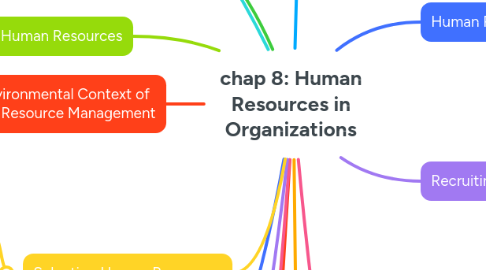chap 8: Human Resources in Organizations
por Huế Trần

1. The Environmental Context of Human Resource Management
1.1. The Strategic Importance of HRM
1.2. The Legal Environment of HRM
1.2.1. Equal Employment Opportunity
1.2.1.1. Affirmative action
1.2.1.2. Americans with Disabilities Act
1.2.1.3. Civil Rights Act of 1991
1.2.2. compensation
1.2.2.1. Fair Labor Standards Act of 1938 (FLSA)
1.2.2.2. Equal Pay Act of 1963
1.2.3. benefits
1.2.3.1. Employee Retirement Income Security Act of 1974 (ERISA)
1.2.3.2. Family and Medical Leave Act of 1993 (FMLA)
1.2.4. Labor Relations
1.2.4.1. National Labor Relations Act
1.2.4.2. National Labor Relations Board (NLRB
1.2.4.3. Labor Management Relations Act
1.2.5. Health and Safety
1.2.5.1. Occupational Safety and Health Act of 1970 (OSHA)
1.2.6. Emerging legal issues
2. Human Resource Planning
2.1. Job analysis
2.2. Job description
2.3. Job specification
3. Recruiting Human Resources
3.1. Internal recruiting (Promotion from Within)
3.2. External recruiting: Getting people from outside the organization to apply for jobs
4. Selecting Human Resources
4.1. Application Blanks
4.2. Tests
5. Managing Labor Relations
5.1. Collective bargaining
5.2. Grievance procedure
6. Contingent and Contemporary Workers
6.1. Contingent and Temporary Workers Are not permanent or full-time employees
6.2. Managing Contingent and Temporary Workers
7. Managing Diversity in Organizations
7.1. Individual Strategies
7.2. Managing diversity in organizations
8. Managing Workforce Diversity
8.1. Higher productivity; lower turnover and absenteeism Increased reputation as “good place to work” Better understanding of different market segments Increased creativity and innovation
9. Determining Benefits
9.1. Pay for time not worked Life, health, and other insurance Service benefits Cafeteria benefit plans
10. Determining Compensation
10.1. Forms of compensation
10.2. Purposes of compensation
11. Performance Appraisal
11.1. Reasons for performance appraisal Validates the selection process and the effects of training Aids in making decisions about pay raises, promotions, and training Provides feedback to employees to improve their performance and plan future careers
11.2. udgmental Appraisal Methods Compares employees directly with each other Difficult to do with large numbers of employees Difficult to make comparisons across work groups Employees are ranked only on overall performance Does not provide useful information for employee feedback
11.3. 360-degree feedback
11.4. Performance Feedback
11.5. Focus of Appraisal Discussion
12. Training and Development Evaluation
12.1. Training and development programs should always be evaluated.
13. Developing Human Resources
13.1. training
13.2. development
13.3. assessing training needs
13.4. common training methods
14. Selecting Human Resources
14.1. interviews
14.2. assesment centers
14.3. other techniques


